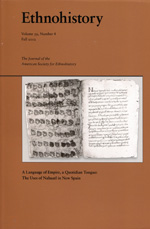A language of Empire, a quotidian tongue: the uses of Nahuati in New Spain
(Ethnohistory, Volume 59, Nº4, 2012)
- ISBN: 9780822367758
- Editorial: Duke University Press
- Fecha de la edición: 2012
- Lugar de la edición: North Carolina. Estados Unidos de Norteamérica
- Encuadernación: Rústica
- Medidas: 22 cm
- Nº Pág.: 127
- Idiomas: Inglés

This special issue of Ethnohistory highlights new aspects of the use of Nahuatl as a lingua franca during the colonial period. The language of the Aztecs, Nahuatl was also spoken by mestizos, mulatos, and Spaniards. By emphasizing interethnic communication in largely quotidian contexts, this issue breaks new ground in the examination of colonial language, investigating the many ways in which Nahuatl shaped the lives of all inhabitants of New Spain. One essay shows how the bilingual ability of many mestizos and mulatos, which resulted from acculturation to both indigenous and Hispanic society, facilitated cultural and linguistic transfer across ethnic boundaries. One contributor considers the use of Nahuatl by clerics, including early-colonial creole clergy, while another uses inquisitorial records to argue that the Church frequently lacked the translators required to conduct its investigations. The issue also reproduces a unique Nahuatl-language sermon, demonstrating the influence of Nahua aides in modifying the messages conveyed by catechistic documents. Another contributor argues that classical Nahuatl's utility as an imperial lingua franca was limited and influenced by Pipil, a form of Nahuatl spoken in the region prior to the Nahua-Spanish invasions of the sixteenth century.






